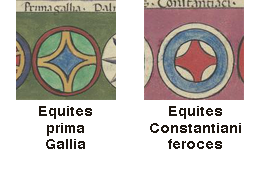
This page created 23 August 2014, and last modified: 7 December 2015 (references rearranged)

The Equites Constantiani feroces is listed (102/5.21 in Ingo Maier's numbering scheme) as the ninth of the vexillationes comitatenses in the Magister Equitum's cavalry roster; it is assigned (102/5.229) to his Gallic command as the Equites Constantiaci feroces. Its shield pattern (100#19) as shown in various manuscripts, under the label (100.t) Constantiaci, is as below:

Note that Seeck accidentally listed the unit as the Equites Constantiani felices (OC.VI.62); this was later corrected in an addenda, but is often missed by not only casual readers but many scholars as well.
The unit's pattern has a white rim and main ground, and features a red cross with curved arms giving the impression of a wheel, the wheel's tyre is blue rather than red (broader in P and W than in O, B and M). Accordingly, the shape of the pattern, but not the colours, is somewhat similar that of the Equites prima Gallia (102/5.14), also in the Magister Equitum's Gallic command, as a comparison of the following patterns taken from the Parisian manuscript shows:

The pattern is also somewhat similar to that ascribed to the infantry unit the Honoriani ascarii seniores (98/9.91), also in the Magister Equitum's Gallic command, as can be seen by examining its shield pattern, as found in various manuscripts:

The name Constantiani/Constantiaci would appear to refer to either the Tetrarchic emperor Constantius Chlorus, or perhaps his grandson Constantius II. It could also refer to another member of his family - Constantinus I, Constantinus II, or Constans, with a slight spelling variation. Due to the prolific nature of the Imperial dynasty established by Constantius Chlorus, the name Constantiani, or variations thereof (e.g. Constantiaci, Constantini, Constantii, Constantaci, Constantiniani...), is shared with many other units in the Notitia. However, the name need not be directly derived: many places were named after members of the dynasty, and some units may have taken their names from being stationed at such a place rather than directly from a personnage (see the Prima Flavia Gallicana Constantia, 98/9.138, for one such example).
A.H.M. Jones, however, considered that the unit must have been named after the much later Constantius III (who reigned in 421), on the basis the unit is listed below units named after Honorius (102/5.18, 102/5.18). That may be so, but since it is also listed above another unit named after Honorius (102/5.38), his use of the word "must" was inapposite (Jones apparently ignored this entry since it was for an African-based unit, the (Equites) Honoriani iuniores, but I am not sure I see the relevance of this qualification).
The name feroces means "ferocious", and is seemingly an apt name for a military unit, but is not a common one in the Notitia: the only other unit sharing the name is the previous one in the Magister Equitum's list: the Equites Mauri feroces (102/5.20).
1. Ingo Maier; "Appendix 4: Numeration of the new edition of the compilation 'notitia dignitatum' (Cnd)"; last accessed 26 October 2015. See also for here for numbering examples. Return
2. Otto Seeck (Ed.); "Notitia Dignitatum accedunt Notitia urbis Constantinopolitanae et Latercula prouinciarum", Weidmann, Berlin, 1876; available here (last accessed 26 October 2015); at p 337. Return
3. A.H.M. Jones; "The Later Roman Empire, 284-602; A Social, Economic, and Administrative Survey"; Blackwell, Oxford, 1964; vol. 3 of 3, at pp 353, 356. Return

Return to the Notitia alphabetical unit list page.
Return to my Notitia index page.